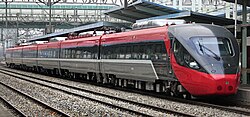This article needs additional citations for verification .(May 2014) |
| Saemaeul-ho | |
|---|---|
 Retired Car-type Saemaeul-ho train hauled by a Hyundai Precision GT26CW-2 locomotive at Suwon Station. | |
| Overview | |
| Service type | Regional rail |
| Status | Operating (along Janghang Line) |
| Locale | South Korea |
| First service | February 10, 1969 |
| Successor | ITX-Saemaeul |
| Current operator | Korail |
| Route | |
| Termini | Yongsan Iksan |
| Stops | 18 |
| Line used | Janghang Line |
| Technical | |
| Rolling stock | |
| Track gauge | 1,435 mm (4 ft 8+1⁄2 in) standard gauge |
| Saemaeul-ho | |
| Hangul | 새마을호 |
|---|---|
| Hanja | 새마을號 |
| RR | Saemaeulho |
| MR | Saemaŭrho |
The Saemaeul-ho,formerly known as the Saemaul-ho and Saemaul Express,is a class of train operated by Korail,the national railroad of South Korea,since February 8,1969. Before the introduction of the KTX express trains,the Saemaeul-ho was the fastest class of trains in South Korea,making the journey from Seoul to Busan in less than 5 hours. Saemaeul trains operated on several lines,but they now only operate on the Janghang Line.
Contents
- Rolling stock numbers
- Carriage
- Rectangular carriage
- Streamlined carriage
- Long carriage
- Remodeled carriage
- Mugunghwa-ho remodeled carriage
- Related culture
- Social status
- Restaurant Car
- Lines served
- Former operations
- Notable accidents
- Three consecutive fatal collision accidents
- See also
- Gallery
- References
- External links
Saemaeul-ho trains are distinguished from the more basic Mugunghwa-ho trains by their larger and comfortable seats and the absence of standing passengers. Trains are also distinguished from the Mugunghwa-ho trains by their colour;typical Saemaeul train passenger cars are painted in red and black. In the past,Saemaeul passenger cars were painted in green,blue,and yellow. The length of a Saemaeul train varies from 5 cars to 12 cars,either as one or two sets;certain Saemaeul-ho trains that ran from Seoul to Busan separated at Gupo station,with one half travelling along the Bujeon Line and Donghae Nambu Line to Haeundae,and the travelling down the main Gyeongbu Line to Busan station.
The Saemaeul-ho took its name from the Saemaul Undong,a movement for rural revitalization spearheaded by Park Chung-hee in the 1970s.


The Saemaeul-ho class was phased out on all lines except the Janghang Line by the ITX-Saemaeul starting on May 12,2014. The new ITX-Saemaeul trains have a faster average speed of 150 kilometers per hour,and replaced the older Saemaeul trains gradually until April 30,2018. [1]









